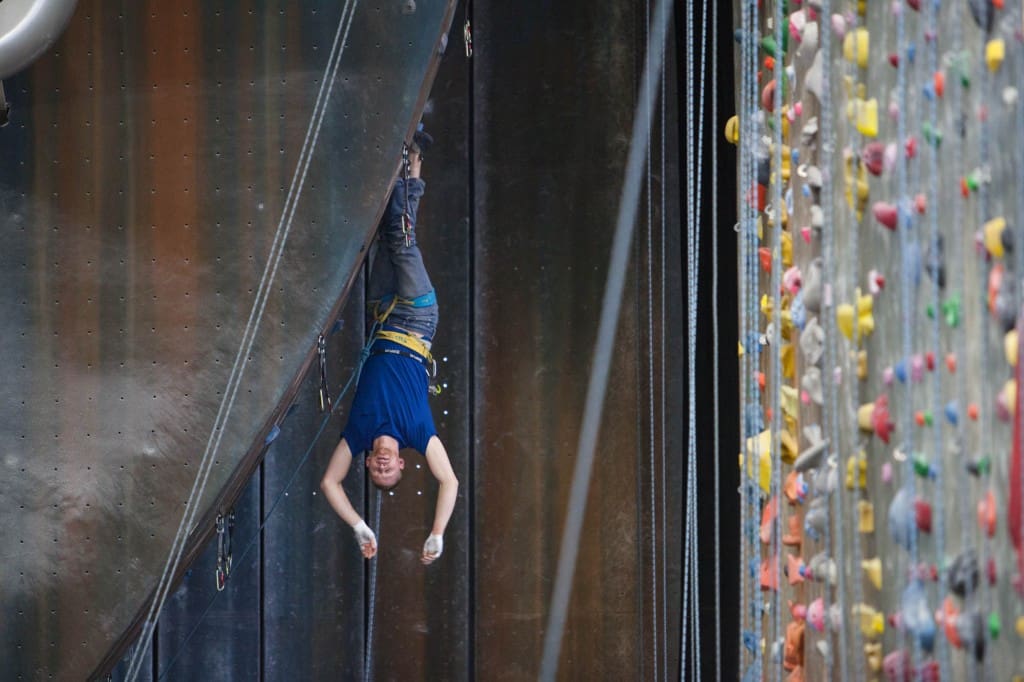Story by Jani Holder /
Remember to breathe.
You’re halfway up your project, and you’re gripped. You’re pumped, losing strength, and feeling miles away from your next clip. And, just because things weren’t tough enough, your leg is starting that infamous sewing-machine action beneath you.
This situation can go one of two ways: you can start the cycle of panicked over-gripping, getting increasingly fatigued and scrambling in a mad sprint to the anchors, hoping you make it before your muscles collapse. Alternatively, you push your heels down. You feel your breath moving and your muscles releasing, instilling a sense of confidence and stillness within you. Take a moment, take the pressure off of yourself, and simply breathe. The simple act of giving your brain and muscles more oxygen to work with does wonders for your abilities, but what if you took it a step further and added some intention to your breathing?
If you’ve ever been to a yoga class, your instructor probably encouraged you to match your movements to your breath. You may even have been lead through some breathing exercises. If you noticed that this improved the connection between your mind and your body while helping you let go of things that weren’t serving you, think of how a similar effect could help you while climbing. We’ll go over a couple of ways to breathe on the wall, whether while moving or while resting, but first, let’s touch on why pranayama (the extension of breath) helps us.
Get parasympathetic.
Think of your autonomic nervous system as being two sides of the same coin: sympathetic and parasympathetic. The sympathetic aspect is what gives you your fight or flight response; it’s the part of your brain that keeps you alive when there’s a real danger but doesn’t necessarily serve you in situations of perceived risk. I’m not telling you that climbing is always safe, but the sympathetic nervous system doesn’t take time to think about the belay system—it feels the exposure and can go into panic mode. Freezing might help you if you find yourself suddenly on an unstable ledge with no rope, but your brain can get confused and think that being on the wall in the gym requires the same response. The parasympathetic side is the side that responds instead of reacting; it’s the calmer side that lets you think things through, which makes it the side we want active when we’re on the wall. It’s the side that can be reasoned with, so it helps us make rational decisions while climbing (and keeps it fun).
Breath is what we can use to trick our brain back into the parasympathetic side. Think of the last time you got spooked—maybe it was when you heard a noise while walking your dog down a sketchy alley, or when the power went out while you were in the basement. You probably gasped, sucking air in quickly. Now, think of when you last felt really relaxed. Petting your dog by the campfire, or sitting in bed with a book and a cup of tea—whatever your fancy. You may not have noticed at the time, but your breath was probably slow and fairly even.
Just as these situations can trigger these breaths, choosing one breath pattern or the other can trigger a response from either side of your nervous system.

Even if you know you’re on belay or have a great spotter, your sympathetic nervous system can still rocket you into panic mode.
Methods.
I won’t pretend to know or have time to explain all of the potential methods, but we’ll start with one of the simplest: counting your breath. Inhale for four, exhale for four. Go ahead, try it while you’re sitting there, I’ll wait. You can work on expanding this further, by counting more or by adding a hold at the end of your inhale or exhale. It’s really surprising how fast we normally breathe, and how much we can do for ourselves by slowing down.
Alternate nostril breathing is next on the list. You’ll probably want to find a comfy spot to hang out on the wall and ask your belayer to take for this one. Take your pointer and middle fingers, bring them to your forehead and use your thumb and ring finger to block off one nostril at a time. The right nostril encourages energy; the left nostril promotes calm. Warm and cool, sun and moon––whichever theory you’re going with translates to the same thing. You can pick one nostril to repeat if you feel you need more energy or more ease, or if you’re a hot mess of emotions simply alternate after each inhale.
If you’ve used three-part breathing in yoga class, this one will sound familiar. Your teacher may have used imagery like filling a vessel with water and then emptying it slowly. The premise is to train yourself to maximize your lung capacity. Think of filling your belly, then ribs, then chest with air and then reverse the process, and use the imagery to move slowly and methodically even though you know that your lungs don’t literally work like that. Just like how we usually breathe faster than we think, we also fill surprisingly little of our lung volume when we’re not thinking about it. Consciously breathing with this exercise can help us learn to use it all.

Why not hang for a bit and try out different breath exercises on the wall? Well… maybe not *quite* like this. Photo by Jon Vickers.
These should be easy to incorporate into your wall sesh, but I have a few more tips to set you up for success:
First, practice before you get on the wall. Give these a try on your yoga mat, your couch, the bench in the bouldering area….wherever, really. Just do it before you’re in the previously described gripped situation.
Secondly, talk to your belayer. As always in climbing, communication is one of the biggest safety precautions we take. In this case, it just helps you and the belayer get on the same page—they know you might be taking a break to work on your breath, and won’t be worried that you’re ill. This also saves you from trying to awkwardly shout down an explanation.
Finally, get on the wall and stabilize yourself. Get below your bolt, sit back in your harness, spread your feet on the wall, and get comfortable. Focus on one spot that isn’t moving or consider letting your eyes close to help you block out your surroundings.
I hope you get the chance to incorporate some of these into your training. Good luck!




Seriously need to work on my breathing to improve my stamina in my climbs! Thank you for sharing this article!:) Its really helpful
Love this, it’s so practical! Even when you’re heard it before, it’s important to read it again, and take some time to practice more.